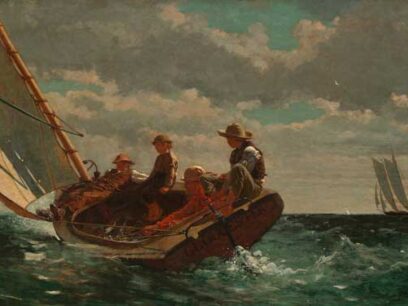May 2, 2010
Breezing Up (A Fair Wind) 1873-1876

Gift of the W. L. and May T. Mellon Foundation 1943.13.1
Homer developed a penchant for forceful realism early in his career. Following an apprenticeship in a Boston lithography shop, he supported himself as a freelance illustrator, creating a wide variety of popular images that subsequently were published as wood engravings in national periodicals like Harper's Weekly. During the early 1860s, his themes ranged from stylish seaside-resort life to the horrors of the battlefield. Following an extended trip to Europe in 1866-1867, Homer adopted a warmer palette, a looser brush technique, and an interest in painting outdoor scenes that owed much to the influence of contemporary French artists such as Courbet, Manet, and Monet.
Upon his return to the United States, Homer turned his attention to lively scenes of sports and recreation, painting warm and appealing images that perfectly suited the prevalent postwar nostalgia for a simpler, more innocent America. Breezing Up, painted during the country's centennial year, has become one of the best-known and most beloved artistic images of life in nineteenth-century America.
Artist Bio
Winslow Homer was born in Boston, Massachusetts, in 1836, the second of the three children, all sons, of Henrietta Benson and Charles Savage Homer. His artistic education consisted chiefly of his apprenticeship to the Boston commercial lithographer John H. Bufford, and a few lessons in painting from Frédéric Rondel after that. Following his apprenticeship, Homer worked as a free-lance illustrator for such magazines as Harper's Weekly.
In 1859 he moved to New York City, where began his career as a painter. He visited the front during the Civil War and his first important paintings were of Civil War subjects. In 1867 he spent a year in France. At Gloucester, Massachusetts, in 1873 he began to paint in watercolor. In 1875 he submitted his last drawing to Harper's Weekly, ending his career as an illustrator. He traveled widely in the 1870s in New York State, to Virginia, and Massachusetts, and in 1881 he began a two-year stay in England, living in Cullercoats, near Newcastle.
Returning to America in 1883, he settled at Prout's Neck, Maine, where he would live for the rest of his life. He continued to travel widely, to the Adirondacks, Canada, Bermuda, Florida, and the Caribbean, in all those places painting the watercolors upon which much of his later fame would be based. In 1890 he painted the first of the series of seascapes at Prout's Neck that were the most admired of his late paintings in oil. Homer died in his Prout's Neck studio on September 30, 1910. [This is an edited version of the artist's biography published, or to be published, in the NGA Systematic Catalogue]
Preserving America’s Sailing Legacy
Engaging Sailing’s Next Generation
Stay Connected to the National Sailing Hall of Fame
